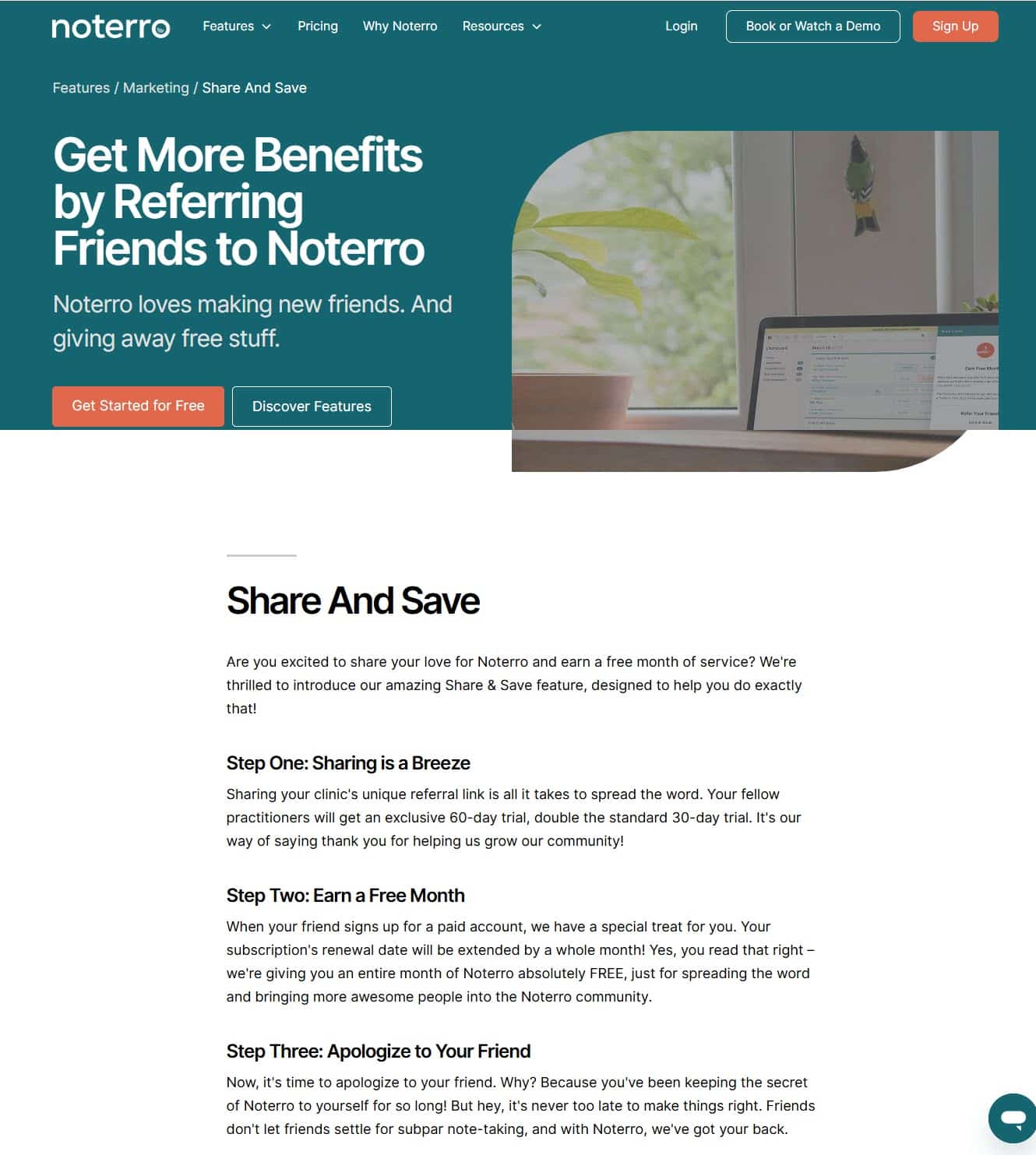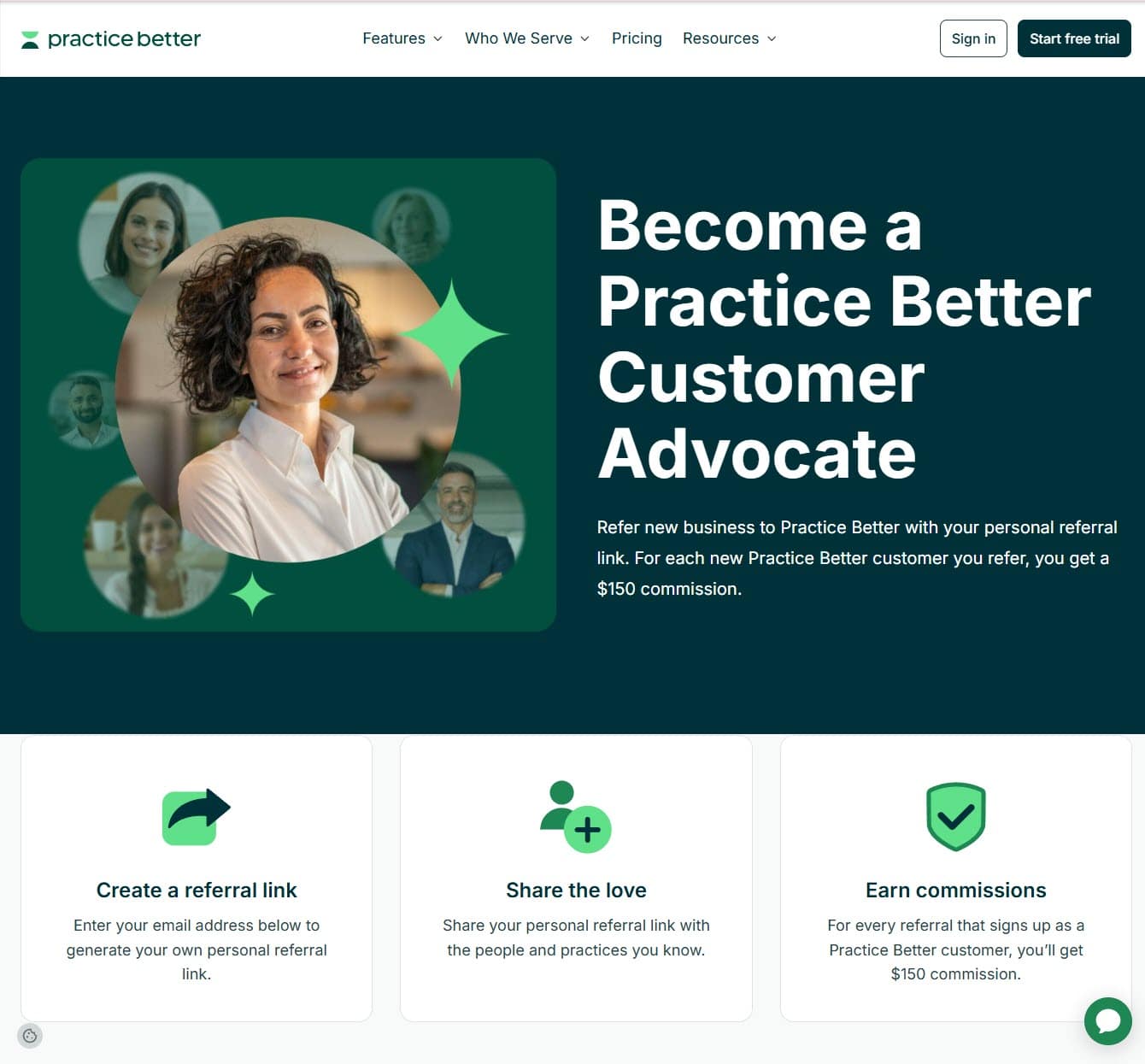Looking for more healthcare clients for your health tech B2B? Your existing clients are your best spokespeople, as they can vouch for how much your products and services have helped their practice and their patients. But how to get them to share with friends reliably? Make sharing easier – and more rewarding – with a health tech referral program. Here’s how to start one.
What is a health tech referral program?
A health tech referral program is a great marketing strategy for your healthcare B2B to boost word of mouth. It encourages healthcare professionals at the practices, hospitals, and other providers you already serve to recommend your service to other healthcare businesses, and offers them rewards when their referrals turn into qualified leads or customers.
Clients can effortlessly participate in a referral program by sharing their unique referral link and claiming their rewards with just a few clicks. Plus, with the right referral tracking tool, launching and managing a successful referral campaign can be a breeze.
Health tech referral programs work well for businesses that offer:
- Practice management software
- Healthcare recordkeeping software
- Patient scheduling solutions
- Telehealth solutions
- Medical devices to healthcare practices
Benefits of health tech referral programs
Health tech referral programs are designed to engage your business clients who already have a reason to recommend your products or services to their peers. By fostering trust, you can grow your client base without the need for expensive marketing tactics. Here are the key advantages of health tech referral programs:
Enhanced brand visibility: Referral programs tap into the excitement of happy clients who share their positive experiences. This word-of-mouth promotion not only helps establish a solid reputation for your business but also boosts social proof and piques the interest of potential clients.
Greater trust in your offerings: Referrals are often seen as more credible than advertisements or messages from your brand. According to a Nielsen study, 84% of people consider referrals to be the most trustworthy and effective form of advertising.
Generation of warm leads: When clients recommend your services, they connect you with businesses that could actively benefit from your solutions. These referrers are familiar with your offerings and can introduce you to others who would gain from your expertise.
Higher conversion rates: A personal recommendation significantly increases the likelihood that others will choose your business. Because of the trust factor, they are more inclined to engage with you. Research indicates that a personal endorsement can be up to 50 times more effective in driving purchases compared to traditional business advertisements.
Cost-effective and low-risk: Referral programs tend to cost less than traditional ads. Plus, with a referral program, you only pay out rewards when a client generates new business. This is much less risky than ads and other marketing methods, where you must pay before you see any results.
Consistent customer loyalty: Referred clients are more likely to remain loyal to your business and continue generating revenue for you. They have a 16% higher lifetime value than customers who come through other means.
Simplified referral tracking: Implementing a referral program makes it easy to monitor referrals. With the right referral software and the links it generates, you can effortlessly attribute each referral to the client who made it.
Before you start a referral program
Not all health tech brands are ready to launch a referral program, even though there are many benefits to doing so.
To ensure your referral program is successful, it’s important to focus on a few key elements.
First, you need to build a strong reputation for delivering an exceptional experience that sets you apart from the competition. Offer a great product that fits your target audience’s needs, and deliver above-and-beyond customer support. What pain points do you solve, and what outcomes have you helped clients achieve? How are they more significant than competitors’ outcomes?
Your current users need to be happy with your platform before creating a refer-a-friend program. If your offerings don’t shine, the referral program may not perform as expected, since people need a compelling reason to spread the word.
Having a dedicated and satisfied customer base is also vital. When clients truly enjoy their experiences with your brand, they are more inclined to recommend you to others.
Reviews, feedback forms, and surveys are great ways to see if you’re ready for a referral program, as they provide valuable insights into how well you’re meeting clients’ expectations. See if there are any obvious pain points or areas you can improve. And if people are already recommending your products or services, that’s a good sign that they’d be even more inclined to do so with rewards involved.
Referral software for health tech companies [Free Tools]
These referral tools for health tech companies are a free and easy way to help you start your referral program.
Free Tools + Services:
- Create your own referral codes - [Referral Code Generator]
- Track referrals manually - [Manual Referral Tracker - Spreadsheet]
- Build referral links - [Referral Link Generator]
- Get best practices and actionable guidance - [Referral Program Workbook]
- Readiness Assessment - [Free Consult]
- Online referral software - [Free Trial]
Want a automated referral system for your health tech business? Uncover referrals in plain sight to smooth out business lulls, without losing focus on your real day to day work helping customers.
Check out our referral program software - done right.
Best practices for health tech referral programs
Now that you know you’re ready for a referral program, follow these tips to help set one up.
Choose the right rewards
Your product and customer service might provide the reason to share, but usually, people need added motivation – in the form of rewards – before they’ll actually share. Creating incentives for both the referrer and the referred party can significantly boost motivation for making referrals, and encourage the referred business to invest in your products or services.
We suggest offering cash referral bonuses or gift cards as rewards, since with health tech B2Bs, the person making the referral may not be the one directly covering the cost of the equipment or software. This could be paid out as a flat reward, or as a commission on a percentage of the sale. The commission model means the reward directly reflects the value of a referral, as the bigger the purchase, the more the referring party receives.
We also recommend giving out a small reward to the referrer when the lead is qualified, and a bigger reward when the lead becomes a paying customer. This is known as a multi-step program. It reflects the longer sales processes that B2B businesses often have, and keeps people engaged with your program since it doesn’t take as long for them to receive a reward.
Or, you might consider a tiered program, where customers can earn larger, cumulative rewards as they bring in a higher number of referrals.
No matter what type of reward structure you choose, make sure your users are automatically rewarded. Don’t make them wait to receive their cash or upgrade.
Use One Click Access to streamline sharing
Simplifying the sharing process encourages more customers to join your program, leading to an increase in referrals. A great way to eliminate obstacles and enhance sharing is by removing the hassle of logging into your program.
With Referral Rock’s One Click Access links, your customers can immediately start sharing your business. They’ll be automatically enrolled in the program, skipping the need to sign up or fill out lengthy forms. All they need to do is provide a bit of information about their friends to send referrals.
Be sure to include One Click Access links in every email you send out to promote your referral program, including newsletters and transactional emails – not just those focused solely on getting referrals.
Additionally, Referral Rock allows both new and existing members to access their referral portal using popular social logins like Google and Facebook, eliminating the need for a password.
Make sharing as easy as possible
A key element of a successful referral program is to simplify the referral process as much as possible. Offer users various options to share your offer, such as through email, social media, and SMS, depending on their preferred communication methods. Additionally, generate a unique referral link for each user who joins your referral program, allowing them to share it in the way that suits them best.
Keep in mind that you’re asking your customers for a favor by promoting your business. If the referral process is too complicated or time-consuming, they may become frustrated and give up. The goal is to minimize the steps involved.
- Make sure that referring someone requires just 1-2 clicks or taps.
- On your referral program landing page, clearly outline the program in 3-4 bullet points, highlighting the rewards and benefits of sharing.
- Provide pre-written messages that users can easily send to their friends without having to come up with their own wording. These messages should feel friendly and be written from the perspective of the referring customer.
- Make sharing effortless on mobile, as that’s where people often share things they enjoy with peers.
- If there’s additional information to convey, include it in a separate FAQ section to keep the main referral page straightforward and user-friendly.
Promote your program on lots of different channels
Once you have your key pieces in place, it’s time to promote your program. Even with all the best practices in place, your referral program won’t see any success if clients don’t know about it. The more participating members you have, the more chances you have to bring in successful referrals (and bring in more revenue). Here are some promotion strategies we recommend:
- Send all your clients dedicated emails promoting your referral program, on a monthly to quarterly basis.
- Incorporate brief promotions for your referral program in newsletters and other regular communications.
- Encourage referrals during video calls you have with clients, if they express satisfaction.
- Send out personal emails asking for referrals if someone leaves a stellar review, gives a high score on a satisfaction survey, or renews their subscription or contract.
- Include information about your program in your invoice emails.
- Add a mention of your program in your email signatures.
- Integrate referral promotions directly within your software or within your client portal, providing direct links for easy access.
- Showcase a prominent banner or hero image on your website’s homepage that links directly to your referral landing page.
- Consider using subtle promotional techniques on your website, such as adding a link in the footer or menu. If users can easily find and access it, they are more likely to engage with your program.
- Share updates about your referral program on your social media platforms.
Keep existing participants engaged
It’s equally crucial to keep your referral program fresh in the minds of users who have already signed up, as they might need a little encouragement to continue sharing. One effective approach is to utilize automated emails that are sent at strategic times.
For example, you could send a reminder email 3-5 days after someone joins your program, congratulate members via email whenever they earn a reward, and take advantage of Referral Rock’s Monthly Summary emails, which provide a personalized recap of each member’s referral activities every month.
Additionally, we suggest sending out promotional emails about your referral program at least once a month during the first year of its operation. After that initial year, aim to send these promotional emails at least quarterly, while also exploring other promotional avenues. This approach not only brings in new referrers but also keeps your program fresh in everyone’s minds, including people who have referred before but have forgotten about the program over time.
Track your ROI
It’s essential to monitor, test, analyze, and enhance your program, whether you develop it internally or opt for a specialized service. Have you checked how many invited users have signed up for your referral program? Which channels are most frequently used for sharing? Marketers should keep an eye on these metrics to determine the effectiveness of the referral program, identify areas for improvement, and assess its overall value. A straightforward way to evaluate this is by comparing costs to revenue.
Your costs include the expenses for rewards and the operational costs of the program. Your revenue reflects the sales generated. If your referral revenue surpasses your customer acquisition cost (CAC), you’re achieving a positive return on investment (ROI) from your referral program. This insight should inform your future actions regarding your referral marketing strategy.
Choose the right referral software
There are many software options that make it easier than ever to create, automate, and customize your referral program. But it’s important to note that many of these tools are targeted to e-commerce, and don’t account for the complexity of B2B or subscription products or sales.
Be sure to choose a platform (like Referral Rock!) that offers multi-step and tiered reward structures, automated payout options, and integration with your CRM and other workflows to effectively track referrals and trigger rewards. Comprehensive analytics and reporting capabilities are also essential.
With Referral Rock, you can:
- Effortlessly track referrals: Each participant receives a unique referral link, allowing you to pinpoint the source of every referral. Customers can also keep tabs on their referral activity through customized dashboards.
- Customize your program: Choose any rewards structure you want, including tiered rewards, multi-step rewards, and commission percentages.
- Automate your marketing: Engage your customers with automated promotional emails and simplify sharing with password-free links. Plus, instantly pay out rewards when they’re earned.
- Integrate with key tools: Connect Referral Rock seamlessly with over 50 different applications, including your CRM.
- Analyze program performance: Quickly assess how your program is doing and make data-driven enhancements.
- Get started quickly: Launch your program in just a few days, with expert assistance available throughout your setup and launch process.
Start a health tech referral program
For the most success with your health tech referral program, keep in mind that you should:
- Offer a service that people genuinely want to share (is it really valuable?)
- Provide appealing rewards to encourage sharing (what do customers get out of it?), and
- Ensure the referral process is smooth and simple (is it user-friendly?)
Referral software can help you put all of these pieces into place, and create a reliable customer acquisition engine.






